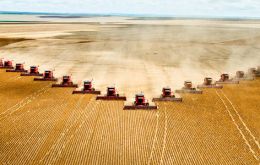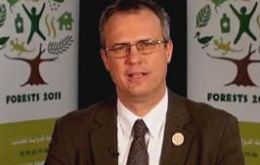MercoPress. South Atlantic News Agency
Tag: FAO
-
Wednesday, January 25th 2012 - 19:37 UTC
FAO underlines importance of agriculture to address world’s environmental challenge

Agriculture is part of the solution to the world's environmental challenge and must play a key role at next June's Rio summit on sustainable development, the Brazilian head of the UN food agency said this week.
-
Thursday, January 12th 2012 - 21:52 UTC
FAO Food prices index in spite of mild drop, reached highest average in 2011

Food prices fell in December 2011 with the FAO Food Price Index dropping 2.4%, or five points from November, FAO said on Thursday. At its new level of 211 points, the Index was 11.3% (27 points) below its peak in February 2011.
-
Wednesday, January 4th 2012 - 05:43 UTC
FAO forecasts more food price volatility with more people at risk of hunger

Food prices may ease in 2012 due to a slowing global economy, though no drastic drop from high levels is expected, the new director-general of the UN's Food and Agriculture Organisation said on Tuesday.
-
Monday, December 12th 2011 - 20:05 UTC
Extended corruption in access to land in 61 countries, claims FAO and Transparency

The UN Food and Agriculture Organization, FAO, and Transparency International have detected serious corruption problems in the access to land in at least 61 countries, among which some in Latinamerica.
-
Monday, November 14th 2011 - 17:13 UTC
FAO: Aquaculture in 2012 will supply more than 50% of world’s fish consumption

Aquaculture is the world's fastest-growing source of animal protein and currently provides nearly half of all fish consumed globally, according to a report published here by FAO.
-
Friday, November 4th 2011 - 08:20 UTC
FAO food price index drops in October but remains higher than in 2010 and volatile

The FAO Food price index dropped to an 11-month low in October, declining 4%, or nine points, to 216 points from September. Nonetheless prices still remain generally higher than last year and very volatile, FAO said.
-
Monday, October 17th 2011 - 06:34 UTC
Every day a billion people go to sleep feeling hungry, recalls UN on Food Day

With nearly one billion people still suffering from food shortages around the globe, the world must take a united stand against hunger, the United Nations said on Sunday 16 October, marking World Food Day.
-
Tuesday, October 11th 2011 - 08:15 UTC
Food high prices and volatility to continue; investment in agriculture critical, says UN

Food price volatility featuring high prices is likely to continue and possibly increase, making poor farmers, consumers and countries more vulnerable to poverty and food insecurity, the United Nations' three Rome-based agencies said in the global hunger report published Monday.
-
Thursday, October 6th 2011 - 22:10 UTC
FAO anticipates ‘tight’ cereal markets in 2011/12 and lower prices

Despite improved production prospects, world cereal markets are likely to remain fairly tight in 2011/2012, FAO announced this week. Prices on the other hand will tend to decline as a result of softer demand because of worsening economic conditions.
-
Tuesday, October 4th 2011 - 06:37 UTC
FAO sponsors protecting trees and forests in cities to improve urban live hood

Focused policies and investments aimed at protecting and managing forest and trees in and around cities are needed to strengthen urban livelihoods and improve city environments, as the world becomes increasingly urbanized.
